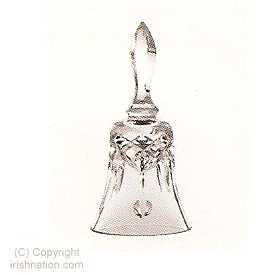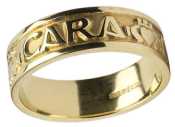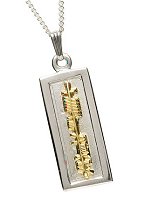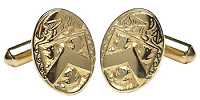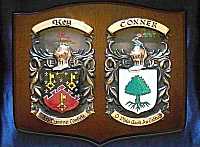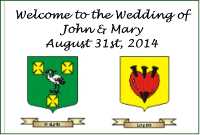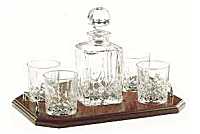You Can Have A Traditional Irish Wedding!
Or at the very least you can add some lovely traditions and Irish Wedding Customs from the Gaelic history of Ireland to your big day.
Modern Irish Weddings can be lavish affairs. It is not unheard of for hundreds of guests to attend a fancy hotel for a swanky reception, for children in formal attire to be employed as page boys, ring bearers and even seating attendants! Some modern couples spurn the traditional Church setting preferring to be wed on a Caribbean beach or perhaps in a foreign Church (with blessings in Rome always proving popular).
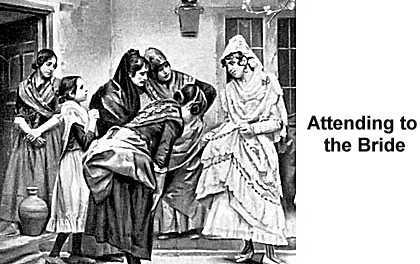
It wasn't always like this!
Irish history is veneered with centuries of oppression that was particularly harsh in respect of the Catholic religion. The 16th Century Penal Laws prevented Priests from saying Mass never mind conducting the Sacrament of Marriage. Sanctions, if a Priest was caught, were severe. The last of the Penal Laws was not repealed in Ireland until 1920.
Given this background and the unique identity of the native Irish people who were forced to practice their religion 'underground', it is not surprising that an Irish Wedding has a particular identity all of its own and has a number of specific traditions associated with it.
WHAT IS THE BEST DAY FOR AN IRISH WEDDING?
In Ireland of centuries ago the most popular day to be married was a Sunday. This made sense as it was the day when the working week was done and people were free to attend the simple marriage ceremonies that were available at the time.
As the decades and years rolled by and as the Catholic religion developed and reasserted itself in Ireland, the choice of Sunday became frowned upon as it was often seen as a mark of disrespect. Similarly, it became unusual for a couple to be wed in May as this was the traditional start of Summer and was marked by a Pagan feast: Bealtane.
These beliefs are the origin of the old marriage song:
Marry when the year is new, always loving, kind, and true.
When February birds do mate, you may wed, nor dread your fate.
If you wed when March winds blow, joy and sorrow both you'll know.
Marry in April when you can, joy for maiden and for man.
Marry in the month of May, you will surely rue the day.
Marry when June roses blow, over land and sea you'll go.
They who in July do wed, must labor always for their bread.
Whoever wed in August be, many a change are sure to see.
Marry in September's shine, your living will be rich and fine.
If in October you do marry, love will come but riches tarry.
If you wed in bleak November, only joy will come, remember.
When December's rain fall fast, marry and true love will last.
In Ireland today most weddings, but by no means all, take place on a Saturday. They are often planned years in advance. This is usually to facilitate visitors to the reception who would otherwise be at their place of work. While it is not at all unusual to have a wedding during a weekday, it can often be inconvenient for guests. Weddings on a Sunday are rare.
HANDFASTING - TYING THE KNOT
Handfasting is an ancient Celtic tradition that involved tying the hands of the betrothed together well in advance of their actual wedding day. It is similar to an engagement, a time when both parties decide if they really wish to commit. In Modern times the tradition occurs on the actual wedding day although in centuries past the ceremony acted as a kind of temporary marriage.
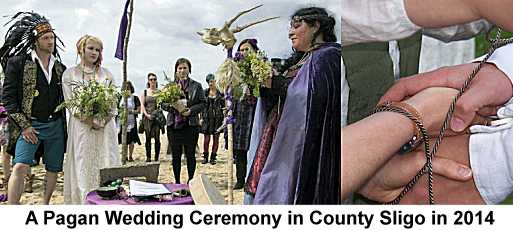 Handfasting was actually a legitimate way for people to be married during the Middle Ages and only declined when laws were enforced making the act of marriage much more formal. Ireland was ruled by 'Brehon law' and handfasting was duly recognised as a proper form of marriage.
Handfasting was actually a legitimate way for people to be married during the Middle Ages and only declined when laws were enforced making the act of marriage much more formal. Ireland was ruled by 'Brehon law' and handfasting was duly recognised as a proper form of marriage.
This tradition is well recorded in Ireland and especially at Teltown in County Meath. The Irish historian John O'Donovan (1806-1861) wrote of the 'Teltown Marriages':
A number of young men went into the hollow to the north side of the wall, and an equal number of marriageable young women to the south side of the wall which was so high as to prevent them from seeing the men; one of the women put her hand thro' the hole in the gate and a man took hold of it from the other side, being guided in his choice only by the appearance of the hand. The two were thus joined hands by blind chance were obliged to live together for a year and a day, at the expiration of which time they appeared at the Rath of Telton and if they were not satisfied with each other they obtained a deed of separation, and were entitled to go to Laganeeny again to try their good fortune for the ensuing year.
In the Pagan and Wiccan traditions the handfasting ceremony may involve an arrangement of rocks, candles, crystals, a robe or ribbon, a broomstick, marriage documents, a silver box and other symbolic items.
USING AN IRISH HERITAGE SITE FOR A WEDDING CEREMONY

In a marvellous development the Irish Government is now allowing couples to hire out some National Monuments and buildings for their wedding ceremony!
Incredible as it may seem you can now get married at:
The Casino at Marino, Dublin
Castletown House, Kildare
Barryscourt Castle, Cork
Desmond Hall, Limerick
Kilkenny Castle, Kilkenny
The Blasket Island Visitor Centre, Kerry
The Ceide Fields Stoneage Visitor Centre, Mayo
It seems certain that other sites will be added. Who knows, maybe it will be possible to be married at the Rock of Cashel or the Hill of Tara - that really would be incredible.
THE WEDDING DAY
Typically a wedding day would begin early with the Bride being attended by her Brides-Maids. Perhaps a hairdresser or make-up artist would be employed to help. Collection of the bride from her home in a fancy decorated limo is often greeted with car-horns and cheers from passers-by. With the Groom eagerly awaiting his fashionably late Bride at the Church her arrival is heralded with a suitable song or music. Presented to her husband-to-be by her father at the altar the nuptials may include the blessing of the wedding rings with the further symbolism of a few pieces of gold or silver also being blessed.
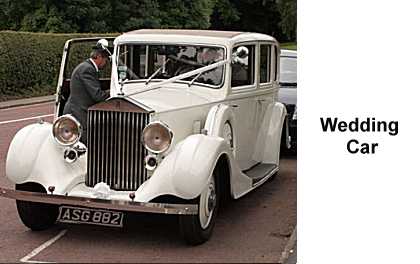 It is not at all unusual for the congregation to clap and even cheer once the magic words are uttered by the Priest: 'I now Pronounce you Man and Wife!'
It is not at all unusual for the congregation to clap and even cheer once the magic words are uttered by the Priest: 'I now Pronounce you Man and Wife!'
The departure from the Church is preceded with some meeting and greeting outside and perhaps a few photos, before the happy couple are brought to their a Hotel for formal photography. Sometimes the wedded couple will depart for a public or private garden for some staged outdoor photos. The Botanic Gardens in Dublin are particularly popular for this although a lot of Hotels that specialize in weddings have their own formal garden for use by the newly married couple.
The wedding guests will have arrived at the Hotel by this time where they can partake of a beverage of their choice. It should be noted that not all wedding receptions are held in Hotels. Sometimes a Restaurant can be booked for the purpose and some other couples choose to have their wedding reception in their own home which, apart from the financial consideration, can greatly add to the intimacy and enjoyment of the event.
Speeches by the Best Man, and often by the Bride and Groom too, take place after the main dining. Telegrams (or Emails, or Twitter posts!) can be read out. Funny anecdotes told. A toast to the happy couple often marks the end of the wedding meal. Music or entertainment is then provided and this can be anything from an unstoppable Auntie determined to sing her song, to a Professional singer or Cabaret act, or perhaps some Irish dancers.
Usually a D.J. or live band round off the evening with plenty of dancing and drinking in evidence.
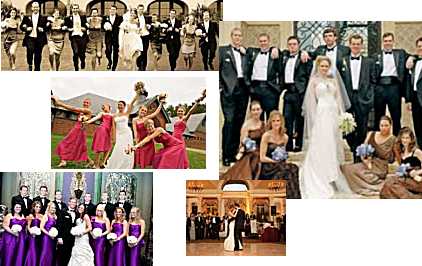 The following morning and having changed from her wedding dress into another carefully selected ensemble the Bride makes her departure with her new husband, often destined for some far flung corner of the globe.
The following morning and having changed from her wedding dress into another carefully selected ensemble the Bride makes her departure with her new husband, often destined for some far flung corner of the globe.
So that is how it done in modern times, but what about the older traditions of an Irish wedding? Read on!
IRISH WEDDING DRINKS
No Irish wedding would be complete without a traditional toast to the happy couple. Of course in modern times this is often completed with Champagne but in the seventeenth century in Ireland this was in very short supply! For many Poteen was the drink of choice!
Poteen is a very strong Whiskey made from potatoes. It was not uncommon for the flavour and recipe to vary from village to village and County to County depending on the type of potato that was refined and the skill of the person doing the refining.
It is now quite customary for a bottle of Champagne or similar to be saved from the wedding reception to be opened when a child is brought into the marriage. The tradition of 'wetting the baby's head' at a Christening means more than the application of water by the Priest! It is a euphemism for celebrating the occasion with a drink.
Mead is another alternative. Mead is an Anglo-Saxon drink originally made by Monks and consists of white wine mixed with honey and herbs. It became very popular in Ireland and is often served in modern times as a 'traditional' Irish wedding drink. The Mead was said to possess magical powers of fertility and thus it became customary for the Bride and Groom to drink the Mead for one full moon after their wedding, giving rise to the word 'honeymoon'.
THE LUCKY HORSESHOE
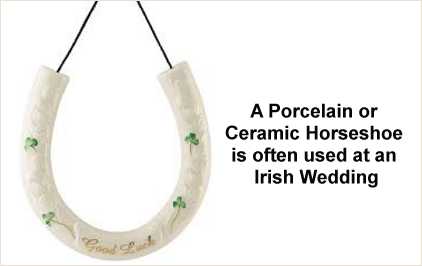 The tradition of a horseshoe is well known throughout the world and so it is in Ireland. By placing the horseshoe upright over a door or in a room the 'luck of the house' was kept intact. The Greeks associated the horseshoe with the crescent moon and its symbolism of fertility. The tradition was popular throughout Ireland and England too with the readily available horseshoe being carried by the Bride as she walked down the aisle. It was then affixed securely by the Groom in the matrimonial home. Today, glass and ceramic horseshoes are symbolically used at Irish wedding ceremonies.
The tradition of a horseshoe is well known throughout the world and so it is in Ireland. By placing the horseshoe upright over a door or in a room the 'luck of the house' was kept intact. The Greeks associated the horseshoe with the crescent moon and its symbolism of fertility. The tradition was popular throughout Ireland and England too with the readily available horseshoe being carried by the Bride as she walked down the aisle. It was then affixed securely by the Groom in the matrimonial home. Today, glass and ceramic horseshoes are symbolically used at Irish wedding ceremonies.
THE MAGIC HANKY
It is now usual for the 'magic hanky' to be made from Linen although it is likely the original versions were made from cheaper materials. It was usual for the Bride to carry the hanky on her wedding day and for it to be retained and later converted to a Christening hat/bonnet for her first child. The hanky would be passed on from generation to generation to be re-used in a similar manner.
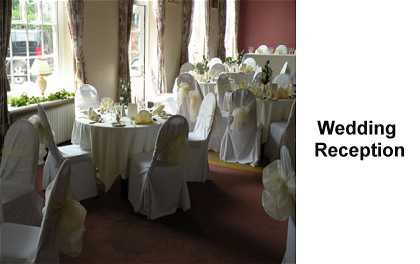 AITIN' THE GANDER
AITIN' THE GANDER
The expression 'his goose is cooked' is still in use in Ireland and especially in Dublin. The phrase originated from the tradition of cooking a goose for the groom in the Bride's house the night before the wedding. Once the goose was cooked there was simply no going back!
WEDDING BELLS
The use of Church bells in Christian religions is symbolic of driving away the evil spirits from the marriage to be. In Penal times in Ireland this was not possible so the gift of a small bell acted as a substitute. Modern Irish weddings often have stationery, invitations, bunting and decorations adorned with bells, hearts, shamrocks and horseshoes. A small glass or ceramic bell can be used in the Church service and kept as a memento.
IRISH DANCERS
The sensation that became 'Riverdance' saw a new interest in Irish traditional music sweep the world. The tradition of having Irish dancers attend at a wedding is a relatively recent one though. It has to be remembered that until Catholic emancipation in the nineteenth century and the revival of the Gaelic consciousness at the turn of the twentieth century, expressions of the Catholic religion were severely restricted. Musically, there are a myriad of Irish songs that are associated with Irish weddings including the poignant 'She Moved Through the Fair'.
THE DOWRY
The tradition of dowry-giving was very well established in rural Ireland and was a source of pride for the family of the Bride. Modernity has relegated this tradition to the history books but in rural areas it is still noted if a Bride brings 'any land' with her.
FLOWERS
It was customary to decorate the house that the wedding celebration was held in with locally grown flowers and plants. These would vary according to the time of the year that the wedding was held. Some plants have become associated with Ireland, not least the now readily available 'Bells of Ireland', used in modern times for its symbolism. A Celtic tradition in Wales involves the plant Myrtle which is presented by the Bride to the Brides-maids who then plant it in their gardens. If the plant grew then the Brides-maid would be married before the year is out!
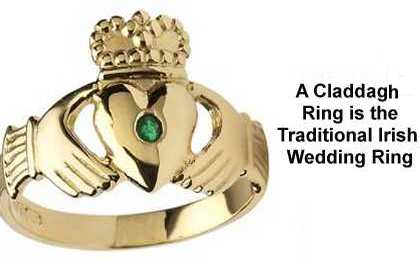 THE CLADDAGH RING
THE CLADDAGH RING
It is very common for a traditional Claddagh Ring to be used at an Irish wedding, most often by the Groom. The ring is faced outwards prior to the wedding and reversed to face inwards on the hand after the wedding, indicating that the bearer is taken forever! The Claddagh Ring is one of the most widespread symbols of Ireland and is very much associated with marriage and romance.
THE WEDDING TOAST
There are many old sayings, Blessings and Toasts that are used at a traditional Irish wedding. Here are three of our favourites:
Friends and relatives, so fond and dear,
'tis our greatest pleasure to have you here.
When many years this day has passed,
fondest memories will always last.
So we drink a cup of Irish mead and ask
God's blessing in your hour of need.'
Guests response:
'On this special day,
our wish to you,
the goodness of the old,
the best of the new.
God bless you both who drink this mead,
may it always fill your every need.'
--------------------------
May your mornings bring joy and your evenings bring peace.
May your troubles grow few as your blessings increase.
May the saddest day of your future
Be no worse than the happiest day of your past.
May your hands be forever clasped in friendship
And your hearts joined forever in love.
Your lives are very special,
God has touched you in many ways.
May his blessings rest upon you
And fill all your coming days.
--------------------------
May the road rise to meet you
May the wind be always at your back
May the sun shine warm upon your face
and the rain fall soft upon your fields
And until we meet again my friend
May God hold you in the palm of his hand
THE WEDDING DANCE
Of course it is a tradition the world over that the Bride and Groom should take center-stage for the first dance of the evening. Unfortunately this tradition has resulted in some pretty horrendous atrocities being committed in full view of digital recording equipment and horrified guests alike.
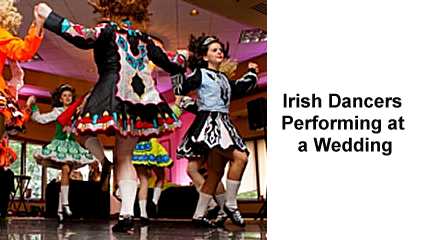 Dont let it happen to you!
Dont let it happen to you!
If you really want to impress then take a few Irish Dancing classes - the basic steps are easy enough to accomplish - you dont have do a full Riverdance although some of your guests may later make the attempt! You may even consider having some traditional Irish music played by a live band, or hire some Irish Pipers - the sky is the limit!
ANCIENT IRISH CUSTOMS
- Not often observed in modern times is the very ancient custom for the Bride and Groom to eat some salt (with oatmeal) on their wedding day to ward off evil spirits. A lot of the superstitions and omens that are associated with an Irish wedding have their root in Catholicism and Gaelic tradition.
- Placing a statue of 'the Child of Prague' in the garden of the Bride prior to the wedding is supposed to ensure that her big day is blessed by nice weather. Some Brides bury the statue in their garden!
- Getting married during a time of plenty, during a harvest, is a good omen for any newly married couple.
- It is preferable that a man should be the first to wish joy to a new Bride, and never a woman.
- On the wedding day itself it was always considered lucky to hear a cuckoo bird or to see three magpies together.
- A wedding party should always avoid crossing paths with a Funeral procession.
- When leaving a Church it is not unusual for rice or confetti to be hurled at the betrothed, but in ancient times an old shoe was tossed over the head of the Bride for luck - not so lucky if it hits the Bride though!
- Perhaps any new mother-in-law should note that to ensure good relations with her new daughter-in-law all she has to do is break a piece of the wedding cake over the head of the Bride as she enters her house after the wedding ceremony. Gently does it though!
- With all that cake and shoes flying around you might think that it would be ok for the Bride and Groom to wash their hands -it is! - but they should never wash their hands together in the same sink, less misfortune unfold.
CONCLUSION
So there you have it! You can pick and choose from any of these Irish Wedding Traditions and add a little Irishness to your big day. Or you can go the whole hog and make the entire event a medieval reenactment - it is up to you!
Click Here to Request a Free Irish Wedding Gift Catalog


 Handfasting was actually a legitimate way for people to be married during the Middle Ages and only declined when laws were enforced making the act of marriage much more formal. Ireland was ruled by 'Brehon law' and handfasting was duly recognised as a proper form of marriage.
Handfasting was actually a legitimate way for people to be married during the Middle Ages and only declined when laws were enforced making the act of marriage much more formal. Ireland was ruled by 'Brehon law' and handfasting was duly recognised as a proper form of marriage.

 It is not at all unusual for the congregation to clap and even cheer once the magic words are uttered by the Priest: 'I now Pronounce you Man and Wife!'
It is not at all unusual for the congregation to clap and even cheer once the magic words are uttered by the Priest: 'I now Pronounce you Man and Wife!'
 The following morning and having changed from her wedding dress into another carefully selected ensemble the Bride makes her departure with her new husband, often destined for some far flung corner of the globe.
The following morning and having changed from her wedding dress into another carefully selected ensemble the Bride makes her departure with her new husband, often destined for some far flung corner of the globe.
 The tradition of a horseshoe is well known throughout the world and so it is in Ireland. By placing the horseshoe upright over a door or in a room the 'luck of the house' was kept intact. The Greeks associated the horseshoe with the crescent moon and its symbolism of fertility. The tradition was popular throughout Ireland and England too with the readily available horseshoe being carried by the Bride as she walked down the aisle. It was then affixed securely by the Groom in the matrimonial home. Today, glass and ceramic horseshoes are symbolically used at Irish wedding ceremonies.
The tradition of a horseshoe is well known throughout the world and so it is in Ireland. By placing the horseshoe upright over a door or in a room the 'luck of the house' was kept intact. The Greeks associated the horseshoe with the crescent moon and its symbolism of fertility. The tradition was popular throughout Ireland and England too with the readily available horseshoe being carried by the Bride as she walked down the aisle. It was then affixed securely by the Groom in the matrimonial home. Today, glass and ceramic horseshoes are symbolically used at Irish wedding ceremonies.
 AITIN' THE GANDER
AITIN' THE GANDER
 THE CLADDAGH RING
THE CLADDAGH RING
 Dont let it happen to you!
Dont let it happen to you!
